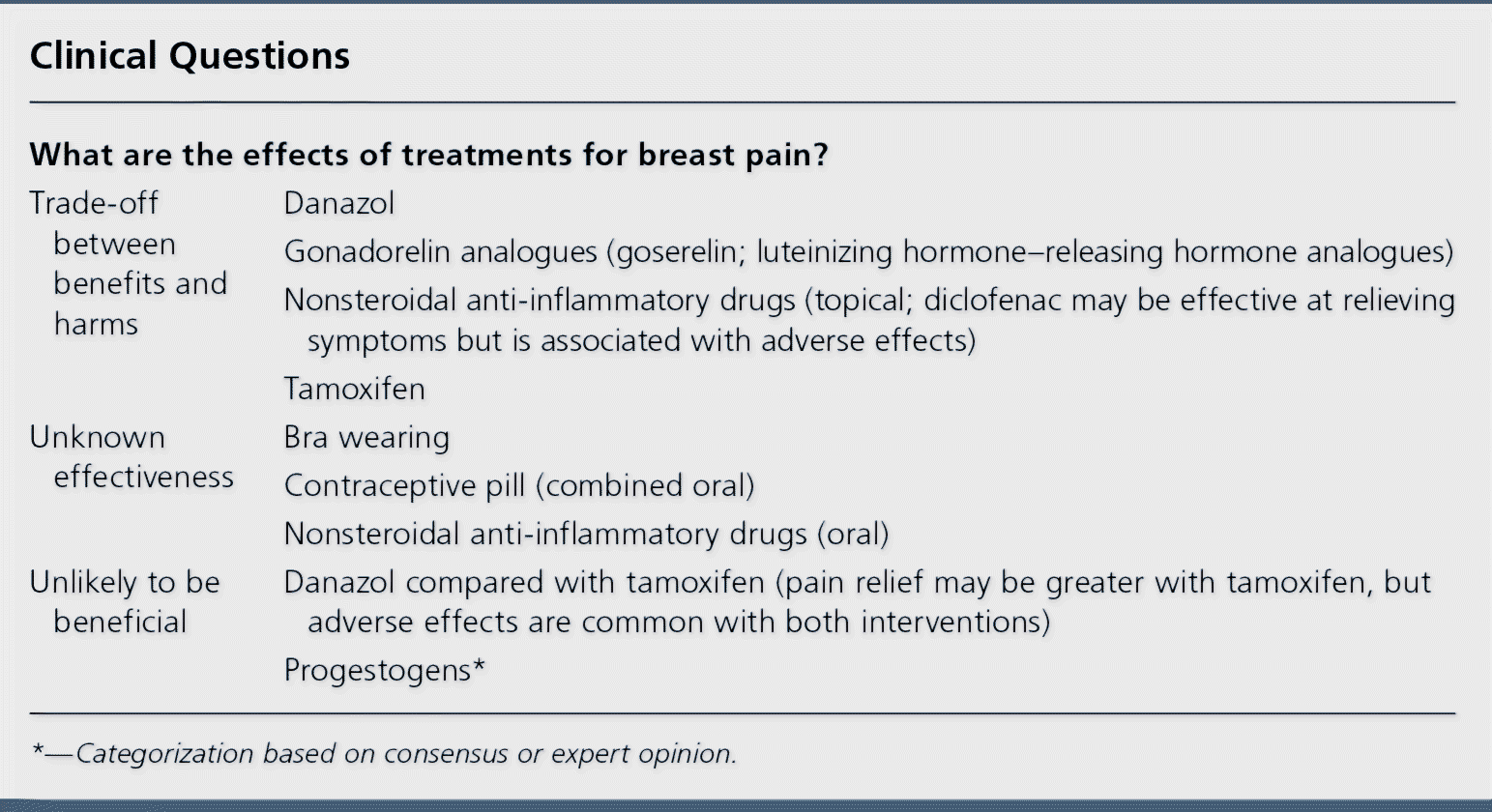
A Publication of BMJ Publishing Group
Breast Pain
Am Fam Physician. 2016;93(10):872-873
Author disclosure: Amit Goyal is an author of references cited in this review.
Breast pain (mastalgia) may be cyclic (worse before a period) or noncyclic, originating from the breast or the chest wall, and occurs at some time in 70% of women.
Cyclic breast pain resolves spontaneously in 20% to 30% of women but tends to recur in up to 60% of women.
Noncyclic pain responds poorly to treatment but tends to resolve spontaneously in about one-half of women.
An accurate diagnosis of true breast pain should be made, and other non-breast pathology should be excluded. The differential diagnosis includes pain arising from the chest wall.
We found limited evidence that topical diclofenac may be effective at relieving symptoms of cyclic and noncyclic breast pain, but it has been associated with adverse effects.
There is consensus that topical non-steroidal anti-inflammatory drugs (NSAIDs) are effective in relieving breast pain and should be considered as a first-line treatment, as the benefits are thought to outweigh the risk of adverse effects.
We found insufficient evidence to assess the effects of oral NSAIDs on breast pain.
We do not know whether topical NSAIDs are more effective than oral NSAIDs at reducing breast pain.
Danazol, tamoxifen, and gonadorelin analogues (goserelin) may reduce breast pain, but all can cause adverse effects. These agents would usually be prescribed only by a subspecialist.
Danazol can cause weight gain, deepening of the voice, menorrhagia, and muscle cramps, and has androgenic effects on a fetus.
There is consensus to limit the use of tamoxifen to no more than six months at a time under expert supervision, and with appropriate nonhormonal contraception, because of the high incidence of adverse effects, including teratogenicity and venous thromboembolism.
Goserelin injection is associated with vaginal dryness, hot flashes, decreased libido, oily skin or hair, decreased breast size, and irritability. There is consensus that goserelin injections should be reserved for severe refractory mastalgia and that treatment should be limited to six months.
Danazol may be less effective than tamoxifen at reducing breast pain and has a less favorable adverse effect profile compared with tamoxifen (10 mg daily).
Tamoxifen (10 mg daily), under expert supervision, or danazol may be considered when first-line treatments are ineffective.
Tamoxifen (20 mg daily) may increase the risk of venous thromboembolism.
There is consensus that progestogens do not have a role in treating mastalgia.
We do not know whether the combined oral contraceptive pill or wearing a bra reduces breast pain, as we found no randomized controlled trials.
Definition

| What are the effects of treatments for breast pain? | |
| Trade-off between benefits and harms | Danazol |
| Gonadorelin analogues (goserelin; luteinizing hormone–releasing hormone analogues) | |
| Nonsteroidal anti-inflammatory drugs (topical; diclofenac may be effective at relieving symptoms but is associated with adverse effects) | |
| Tamoxifen | |
| Unknown effectiveness | Bra wearing |
| Contraceptive pill (combined oral) | |
| Nonsteroidal anti-inflammatory drugs (oral) | |
| Unlikely to be beneficial | Danazol compared with tamoxifen (pain relief may be greater with tamoxifen, but adverse effects are common with both interventions) |
| Progestogens* | |
Breast pain can be differentiated into cyclic mastalgia (worse before a menstrual period) or noncyclic mastalgia (unrelated to the menstrual cycle). Cyclic pain is often bilateral, usually most severe in the upper outer quadrants of the breast, and may be referred to the medial aspect of the upper arm. Noncyclic pain may be caused by true breast pain or chest wall pain, located over the costal cartilages. Specific breast pathology and referred pain unrelated to the breasts are not included in this review.
Incidence and Prevalence
Up to 70% of women develop breast pain in their lifetime. Of 1,171 U.S. women attending a gynecology clinic for any reason, 69% had regular discomfort, which was judged as severe in 11% of women, and 36% had consulted a doctor about breast pain.
Etiology and Risk Factors
Breast pain is most common in women 30 to 50 years of age.
Prognosis
Cyclic breast pain resolves spontaneously within three months of onset in 20% to 30% of women. The pain tends to relapse and remit, and up to 60% of women develop recurrent symptoms two years after treatment. Noncyclic pain responds poorly to treatment but may resolve spontaneously in about 50% of women.
Search Date: February 2014
Adapted with permission from Goyal A. Breast pain. Clin Evid Handbook.

